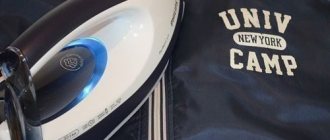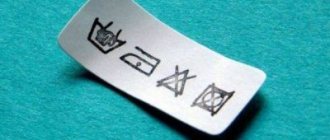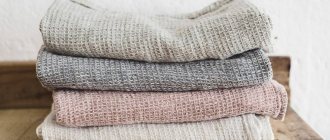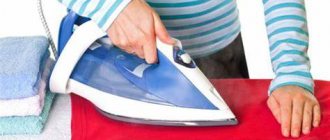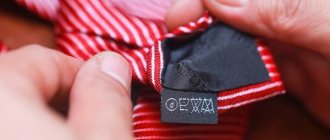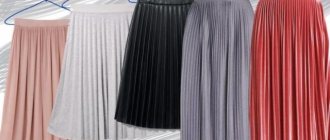Tulle is widely used in interior decoration. But, this material is capricious and needs careful care.
Almost every housewife has at least once faced the question - is it necessary to iron tulle? To answer this question, determine what the curtain is made of.
In this article we will tell you how to quickly iron tulle from various fabrics: in what mode, at what temperature, and what can be used for ironing, except an iron.
Is ironing necessary after washing?
Sometimes ironing of tulle is not required. It depends on what fabric the curtain is made of and how it was washed. Silk, cotton and other heavy fabrics can be hung immediately on the window if they have been washed by hand.
After machine washing, any fabric will have to be ironed. But organza is quite capricious, so an iron will be needed even after a delicate wash.
So that the tulle does not have to be ironed for a long time, it must be washed properly.
For this you need:
Soak the fabric in plenty of soapy water for no longer than 10 minutes. If the curtain is kept in water for a long time, creases may appear on it, which will be almost impossible to get rid of.- Rinse the fabric thoroughly and let the water drain. You can't unscrew it.
- Hang the wet tulle, evenly distributing it along the entire length.
If there are no creases or folds on the fabric, it is simply hung on the curtain rod . All folds will straighten out under the curtain's own weight. But if any irregularities are noticeable, you will have to take out the iron.
Ironing correctly
Finally, a few general recommendations that will be relevant when ironing any fabric.
- When you buy ready-made curtains, they must have a label with care instructions (in what water to wash, at what temperature to iron, etc.). Please read what is written there carefully and follow the instructions carefully.
- Before plugging in the iron, carefully inspect the soleplate - there should be no stains on it. In most cases, black spots are burnt particles of textiles, and if you start ironing without taking any action to clean, the white curtains can be damaged beyond repair.
- Determine what fabric the tulle is made of (synthetics, silk, cotton, other materials). Modern irons have special programs for each fabric, which is what you need to choose. If there are no specific instructions on your iron, then iron the curtains no more than +120 degrees (this is one or two points on the disk).
- It is not recommended to rush or, conversely, “slow down” during the ironing process. If you “walk” across the canvas too quickly, you are unlikely to have time to smooth out the unevenness, and if you constantly linger in one place, you risk burning the curtain. Choose a moderate pace and systematically go through the entire canvas.
- Tulle, like any other fabric, should be ironed only from the wrong side.
- To avoid damaging the curtain, use a thin cotton cloth through which you will iron. Modern models of irons have a special sole, which must be worn when ironing thin fabrics.
- According to experts, the vertical position of curtains is ideal for smoothing. Firstly, because the canvas will straighten under its own weight (even if this weight is small), and secondly, because it will be more convenient to use a steam generator or iron.
- Manufacturers often recommend ironing only completely dry material. However, most of us know that this approach does not give the desired effect. Therefore, it is better not to wait until the tulle is completely dry. And if it happens that the canvas has dried completely, you can do the following trick with some curtains: moisten them with a spray.
- Seams on curtains will require a special approach. They must be ironed from the wrong side. In addition, it is important to ensure that there is not too much pressure, otherwise the seams will be “imprinted” on the front side. To avoid this effect, use gauze.
Tulle is an amazing material, both in its appearance and in its performance characteristics. As befits royalty, he has a difficult “character”, and if you do not exercise caution and attention, you can easily ruin the material. However, many housewives have found a “common language” with delicate and airy tulle, and claim that ironing such fabric correctly is a pleasure. This means that you can ensure that your window opening is designed flawlessly.
How to do everything correctly depending on the material?
The process begins with checking the soleplate of the iron. There should be no scorch marks or any other contamination. If they are found, they need to be removed or use another iron, as dark spots may remain on the curtain.
It is important to set the temperature correctly. This figure above 120 degrees is not acceptable.
It’s good if the iron has a steam function , which will help you smooth out the tulle without difficulty. If there is no such function, then the surface of the ironing board should be covered with damp gauze.
It is better to avoid using a sprayer, as stains may remain on the canvas. Don't wait for the tulle to dry completely. This makes it easier to smooth out.
Cotton
For this material, the minimum temperature setting of the iron is suitable. There is no point in waiting until the cotton fabric is completely dry .
This will only lead to wrinkles that are difficult to smooth out. Therefore, you can immediately hang it in place.
To prevent ironing marks from remaining on cotton tulle, the soleplate of the iron should not heat above 100 degrees . The canvas is laid out face down on the board. You need to use damp gauze on top to protect the fabric.
Gauze and other gaskets are not needed if the iron comes with a special non-stick nozzle.
Linen
Linen also consists of natural fibers. Therefore, he is not at all afraid of high temperatures . To ensure that the fabric is as smooth as possible, it is ironed wet. In a situation where the curtain has had time to dry, use a spray bottle or wet gauze.
To save time, some housewives hang linen tulle without waiting for it to dry. Drying in this position in a warm room, the curtain will take the shape it needs.
Silk
Silk tulle can be ironed on its own, without the use of an iron. Therefore, after squeezing it slightly, it is hung in place.
At room temperature it will dry and take on an attractive, even appearance.
If creases are visible on the fabric, it will have to be ironed. To do this, place a sheet of white paper under the fabric. You should not spray silk from a spray bottle ; this will protect it from streaks on its surface.
It is also better to cover the top of the silk curtain with paper or gauze and iron it only this way.
Organza
Organza is a light and airy fabric that has an attractive appearance. But, despite its beauty, such tulle is very capricious.
Some rules will help make organza ironing easier:
- When washing organza, the fabric should be rinsed in salted water, which will prevent wrinkles from appearing.
- Organza should be ironed at the most gentle temperature conditions. It is also advisable to place a sheet of paper or wet gauze between the iron and the curtain.
- During drying, this fabric cannot be folded, otherwise creases will appear, against which even an iron will be powerless.
- The ideal option for ironing organza is to use a steamer. This can also be done in a canopy, when the fabric is not yet completely dry.
Nylon
For ironing, use some tricks:
Nylon tulle is ironed wet.- Ironing begins from the most inconspicuous area. These actions check the correctness of the selected temperature regime.
- The iron should “hover” over the surface, i.e. practically do not touch the material.
- Some iron models have special attachments.
When used, no traces are left on the material. In the absence of such a device, the top of the product is covered with gauze.
Polyester
Polyester is very difficult to care for . Even if it is washed correctly, difficulties may arise during ironing. And such tulle is not capable of straightening itself on its own.
In addition, you must choose the right mode. The temperature of the soleplate of the iron should not exceed 100 degrees.
Synthetic fabric is ironed damp. To do this, lay it out on a hard surface with the wrong side up.
To avoid damaging the fabric, ironing should begin from a corner or other inconspicuous area. Additional protection will be the use of gauze.
Viscose
To prevent viscose tulle from losing its color, you only need to iron it from the inside out, using steaming.
The temperature regime must be selected carefully , checking it on an inconspicuous area of the tulle. Optimal - 120 degrees.
To prevent streaks from appearing on the canvas, it is prohibited to use a spray bottle.
Steaming viscose is allowed only in a vertical position. If you try to do this on an ironing board, the fabric may become covered with waves.
Tulle that does not require ironing
Indeed, there are fabrics that do not require ironing; let’s call them “the housewife’s dream.” These fabrics either do not wrinkle at all or only need ironing occasionally.
- Fabrics with a high synthetic content. Some synthetic fabrics do not require steam treatment, ironing or any other smoothing devices. These materials are simply hung up immediately after washing and left to dry and iron at the same time. If the fabric is still very wrinkled, then it is recommended to iron it at a temperature no higher than 120 degrees.
- Cotton fabrics. A little higher we mentioned that cotton fabrics can simply be hung on a curtain rod by squeezing them lightly with your hands. For washing, the delicate mode is used, and the automatic spin is completely turned off. Under their own weight, the canvas smooths out well during the drying process.
- Tulle with the addition of linen threads. The greater the flax composition, the more the linen wrinkles. If you need to iron linen tulle, iron it in the same way as cotton curtains: at a temperature of 100 degrees and through a thin fabric.
Large size curtain
Difficulties may arise if the tulle is large. A large curtain begins to be ironed from the top .
It is placed on a flat horizontal surface, for example, an ironing board, and the tulle is gradually removed from it. At the moment when the ironed edge reaches the floor, it is hung on the cornice and the remaining area continues to be ironed. This method is very convenient and simple.
There is another simple way.
- The curtain is hung damp.
- An ironing board is placed at the place where the product is placed, on which the ironing process will take place.
- Having reached the middle of the curtain, it is hung over the other end, and the rest of the curtain is ironed.
A long piece of tulle can be ironed without even having an ironing board. In such a situation, a wide board and a round stick with a smooth surface about 1.5 meters in length are used.
The fabric is wrapped around the board and ironed. To prevent the ironed part from becoming wrinkled, it is carefully wrapped around a stick, checking that there are no creases in the material.
How to wash tulle so as not to iron it in the future
There is a washing method that will allow you to avoid ironing. It will not be possible to save much time, since it involves exclusively manual work, without the use of a washing machine.
The procedure is as follows:
- A mixture of water and detergent is poured into a large container. Liquid chemicals are best suited because... grains of powder are difficult to rinse out.
- The products are soaked for 2-3 minutes, after which they are washed immediately. Leaving delicate materials in water for a long time is not recommended.
- The water is drained and the curtains are rinsed. No need to squeeze. Excess water should drain naturally.
- The tulle is immediately hung on the cornice. To prevent draining moisture from damaging the floor, you can put rags or substitute containers.
- The curtain is distributed along the entire length of the curtain, making sure that the fabric does not stick together.
- After drying, if creases are still observed, you can go over the product with a steamer.
Organza cannot be smoothed using this method, but other types of materials react well to it.
Another common method is to hang the fabric over a bathtub filled with hot water after washing. Under the influence of steam, the product will dry more slowly, but the unevenness will disappear.
For white items, a method is used that will not only eliminate the need for ironing, but also return things to their original whiteness.
The following actions will be required:
- wash the product manually with laundry soap and rinse;
- prepare a solution of 5 tbsp. l. salt, 40 g of washing powder or liquid detergent, 2 tsp. ammonia and hydrogen peroxide per 9-10 liters of water;
- leave the item in this mixture for 4-5 hours;
- machine wash on a delicate cycle, then hang up without waiting for it to dry;
- mix vinegar (9%) with water and fabric softener and spray the resulting solution onto the tulle.
We use a steamer
Compared to the newest iron, the steamer wins on many counts. This useful device can significantly ease household chores .
Thanks to him, housewives can get rid of many labor-intensive manipulations. Unlike irons, this device produces steam that affects textiles.
The steamer has its advantages:
speed and quality of ironing;- the final result is absolutely not affected by the shape of the products and their material;
- together with the smoothing process, the fabric is disinfected, grease stains are removed and linen is cleaned;
- in addition to dirt and greasy stains, unpleasant odors, allergens and pathogens are eliminated;
- There is no need to remove curtains during ironing.
Steamer usage:
- Clean water is poured into a special reservoir of the device.
- The curtain is hung on the cornice.
- You need to run a steamer over the curtain from top to bottom. Places where tissue is creased deserve special attention.
- If necessary, the process can be repeated again.
This ironing method is not suitable for silk tulle, as steam may cause stains and streaks to appear on this fabric.
A steamer costs a lot of money, so if you need it 1-2 times a year, it is better to rent it or ask friends.
Description of fabric
Tulle is a weightless fluffy fabric that serves as a raw material for production in many industries. This is due to its structure, which is represented by a simple grid or pattern. It is one of the most popular materials, it's all about its versatility. Tulle curtains will add lightness and tranquility to the interior, and clothing elements will give it an interesting design.
Nowadays, curtains made of synthetic fabrics are the most popular.
Today, manufacturers are ready to offer tens of thousands of ideas for the design of windows and doorways, but modern housewives still prefer patterned tulle. This is justified; tulle curtains can maximally change the decoration of your apartment: visually add space to it, hide external defects. Thanks to the homogeneous structure of the matter, the following conditions for caring for it have developed:
- In order for a product made of tulle material to avoid unwanted color, it must be washed frequently;
- Before machine washing, the product must be freed from dust and various types of deposits;
- This fabric should never be soaked in hot water - it may shrink; it is recommended to soak the fabric for 3-4 hours in lukewarm water with soap or soda solution;
During the soaking process, the tulle must be turned over periodically. - You can dry or iron the fabric only in the straightened position;
- You cannot forcibly wrinkle, rub or tug the tulle. the structure of the canvas is very thin, if you carry out such manipulations with it, it will very quickly lose its external qualities;
- curtains are a material that does not require ironing; you can simply hang it in a slightly damp position.
Important! If you wash tulle in a machine, you must choose a mode that does not include spinning, so as not to damage the fabric!
The main thing when machine washing tulle is to choose the right mode.
Is it possible to hang it without removing it?
give tulle a neat look without removing it from the cornice :
Ironing.
The damp curtain is hung on the curtain rod and allowed to hang for some time so that it straightens under the weight of its weight. Next, use the steam function. By exposing the tulle to steam, it is possible to smooth out any creases and other irregularities.- A steamer is the best way to iron a curtain without removing it from the curtain rod. You need to move the steamer slowly over the curtain.
- If you don’t have a steamer at hand, you can replace it with a container of boiling water. It needs to be brought to the curtain and moved along the entire canvas.
Product Features
Tulle is a weightless, pleasant to the touch material, made in the form of smooth or patterned fabric. There are many ways to make tulle, which affect the final set of fabric characteristics:
- Organza.
Polyester is used as the base material in the production of organza, which gives the tulle increased density and resistance to damage. Organza wrinkles less during use and does not accumulate dust on its surface, which is typical for other types of tulle.
- Veil.
The veil differs from other options in its matte fabric texture. Otherwise, it is just as dense and wear-resistant. In the production of veils, cotton, silk and wool fibers are used.
- Net.
Mesh is a tulle that has a cellular structure, thanks to which the tulle transmits light well and has an extravagant appearance. Due to its structure, the curtain collects a lot of dust, which is a significant drawback for people prone to allergic reactions.
- Muslin.
The tulle is made of plain weave, which ensures exceptional strength of the fabric. It is made from both natural and synthetic materials.
- Chiffon.
It combines well with other materials, allowing you to create unexpected combinations of colors and shapes. It is made from cotton or silk, which affects the overall strength of the fabric.
- Kiseya.
The fabric is made by loosely joining individual threads into a common composition, which gives the fabric increased breathability and lightness.
See also
How to smooth linoleum on the floor with your own hands, rules and methods of leveling
How to do without an iron?
There are situations when it is impossible to use an iron. Here are some simple ways to iron tulle without an iron.
In the case where the tulle has barely noticeable creases, it is enough to wet your hands and, as if smoothing out the unevenness, smooth the problem area.
After some time, the product will dry out, and the unevenness will become almost invisible. But this method is not suitable for synthetic products .
General rules
Most curtains can be ironed, and even the thinnest or mesh items can be heat treated after washing. But in order not to spoil the products, you need to focus on the material. To properly iron tulle after washing, you must use a special board or flat surface. Experienced housewives give several useful recommendations:
- It is better to iron tulle a little damp; when dry, it quickly burns and is very difficult to straighten.
- The temperature is set individually depending on the material of the product.
- First, use an iron to straighten the seams with the nose on the front side, and then go over the entire product.
- Do not keep the device in one place for a long time. The result is a yellow spot or hole.
- Steam is used for ironing thick fabrics. Polyester curtains can get damaged.
Tips and prohibitions
Ironing tulle is a rather labor-intensive process; in order to iron out even capricious fabrics, you must follow some rules:
Curtains are best ironed on a hard, horizontal surface. It is allowed to iron a curtain folded in several layers. Only the folds cannot be touched.- The iron temperature should be minimal. For each type of fabric it is different within 80-120 degrees.
- To avoid damaging the fabric, it is better to use a spacer. For example, wet gauze.
- You need to iron the tulle until it is completely dry. It won't be easy to do this later.
How to iron large fabric?
How to iron tulle if it is very large? Many people ask this question. To begin with, you should place the ironing board next to the cornice. The material is arranged vertically, starting from the base of the curtain. It is ironed tightly until it begins to touch the floor on the other side. When the ironed part touches the floor, it is hung on the cornice. Then the material simply moves away!
It is better to iron a long curtain with an assistant
How to smooth curtains on a window
If your household has a vertical steamer or you can rent it, then ironing curtains becomes a real pleasure. When the tank is full of clean water, the resulting steam is left to stroke the tulle while it is hanging. Do this in any convenient direction and any number of times.
Types of steamers are presented in the table below:
| Device type | Description |
| Manual | They iron simple cut curtains. An extension cord is provided. The unit is characterized by low power. |
| Floor | Will cope with complex draperies and many folds. Powerful and efficient device. |
Advice! If there is no such device, a regular kettle with boiling water will help. Direct the steam onto the crumpled curtains, straighten the folds with clean hands.
Basic mistakes when ironing
Due to the fact that there are many rules and recommendations for ironing curtains, not everyone takes them into account when caring for them. Because of this, the products lose their original appearance, stains appear on them, iron marks appear on them, or they simply do not smooth out.
The most common mistakes made are:
Drying curtains in a dryer. After this, many creases and marks appear on the product, which are difficult to smooth out in a completely dry state.- Untimely ironing. Even if you dried the curtains naturally, it will be useless when ironing them after they are completely dry. You need to iron slightly damp and under-dried curtains, then it will be easier to work with them, and you will be able to remove all the wrinkles.
- Strong ironing of seams. Even when ironing them from the wrong side through a layer of gauze, you need to lightly touch them with the iron, without pressing too much. Otherwise, marks from the seams will remain on the front side of the product.
- Using an iron with a dirty surface. Often the fabrics from which curtains are made are very vulnerable and difficult to care for, so they quickly get dirty and absorb dirt. Soot deposited on curtains from an iron can be difficult to wash off, and traces of it remain on the material forever.
- Steaming curtains made of any material. Despite the fact that this ironing method is considered quite delicate, it is not suitable for some fabrics and can only ruin them.
Before processing the curtains, be sure to pay attention to the recommendations for caring for them, which are written on the label from the manufacturer. This way you can maintain the condition of the product and avoid its damage.
